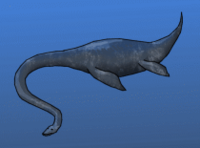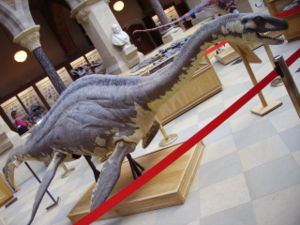Plesiosaur
2007 Schools Wikipedia Selection. Related subjects: Dinosaurs
| iPlesiosaur |
||||||||||||
|---|---|---|---|---|---|---|---|---|---|---|---|---|
 |
||||||||||||
| Scientific classification | ||||||||||||
|
||||||||||||
|
|
||||||||||||
|
Cimoliasauridae |
Plesiosaurs ( IPA /ˈplisɪəˌsɔɹ/) ( Greek: plesios meaning 'near' or 'close to' and sauros meaning 'lizard') were carnivorous aquatic (mostly marine) reptiles. After their discovery, they were somewhat fancifully said to have resembled "a snake threaded through the shell of a turtle". The common name 'plesiosaur' is applied both to the 'true' plesiosaurs (Suborder Plesiosauroidea) and to the larger taxonomic rank of Plesiosauria, which includes both long-necked (elasmosaurs) and short-necked (polycotylid) forms. Short-necked, large-headed plesiosaurs are more properly called pliosaurs. There were many species of plesiosaurs and not all of them were as large as Liopleurodon, Kronosaurus or Elasmosaurus.
Plesiosaurs (sensu Plesiosauroidea) first appeared at the very start of the Jurassic Period and thrived until the K-T extinction, at the end of the Cretaceous Period. While they were Mesozoic reptiles that lived at the same time as dinosaurs, they were not dinosaurs.
The first plesiosaur skeletons were found in England by Mary Anning, in the early 1800s. A virtually complete plesiosaur skeleton was found in 2002, in the cliffs at Filey, Yorkshire, England, by an amateur palaeontologist. The preserved skeleton will be displayed at Scarborough's new Rotunda Museum, from 2007.
It is occasionally claimed that plesiosaurs are not extinct, although the evidence for this belief is generally not accepted in the scientific world. The modern 'sightings' that are occasionally reported are usually explained either as basking shark carcasses or as hoaxes.
Description
Typical plesiosaurs had a broad body and a short tail. They retained their ancestral two pairs of limbs, which evolved into large flippers. Plesiosaurs evolved from earlier, similar forms such as pistosaurs or very early, longer-necked pliosaurs. There are a number of families of plesiosaurs, which retain the same general appearance and are distinguished by various specific details. These include the Plesiosauridae, unspecialised types which are limited to the Early Jurassic period; Cryptoclididae, (e.g. Cryptoclidus), with a medium-long neck and somewhat stocky build; Elasmosauridae, with very long, inflexible necks and tiny heads; and the Cimoliasauridae, a poorly known group of small Cretaceous forms. According to traditional classifications, all plesiosaurs have a small head and long neck but, in recent classifications, one short-necked and large-headed Cretaceous group, the Polycotylidae, are included under the Plesiosauroidea, rather than under the traditional Pliosauroidea.
Behaviour
Unlike their Pliosaurian cousins, Plesiosaurs (with the exception of the Polycotylidae) were probably relatively slow swimmers. It is likely that they cruised slowly below the surface of the water, using their long flexible neck to move their head into position to snap up unwary fish or cephalopods. Their unique, four-flippered swimming adaptation may have given them exceptional maneuverability, so that they could swiftly rotate their bodies as an aid to catching their prey.
Contrary to many reconstructions of plesiosaurs, it would have been impossible for them to lift their head and long neck above the surface, in the 'swan-like' pose that is often shown. Even if they had been able to bend their necks upward, to that degree (they could not), gravity would have tipped their body forward and kept most of the heavy neck in the water.
Taxonomy
The classification of plesiosaurs has varied over time; the following represents one current version (see O'Keefe 2001)
- Superorder SAUROPTERYGIA
- Order PLESIOSAURIA
- Suborder Pliosauroidea
- Suborder Plesiosauroidea
- Family Plesiosauridae
- (Unranked) Euplesiosauria
- Family Elasmosauridae
- Superfamily Cryptoclidoidea
- Family Cryptoclididae
- (Unranked) Tricleidia
- Tricleidus
- Family Cimoliasauridae
- Family Polycotylidae
- Order PLESIOSAURIA
In fiction
The plesiosaur is popular among children and cryptozoologists, appearing in a number of children's books and several films. It fought an icthyosaur in Jules Verne's novel Journey to the Centre of the Earth. In the bizarre 1899 short story "The Monster of Lake LaMetrie", a man's brain was put into the body of a plesiosaur.
It has appeared in films about lake monsters, including Magic in the Water (1995), and movies about the Loch Ness Monster, such as Loch Ness (1996). In both films, the creature primarily serves as a symbol of a lost, child-like sense of wonder. The plesiosaur is also present in the Japanese Jaws-inspired movie Legend of the Dinosaurs (1983). There are also unsubstantiated rumors across the Internet that a plesiosaur may be featured in the upcoming film Jurassic Park IV.
Contrary to reports, the long-necked, sharp-toothed creature in the classic film King Kong (1933), which flips a raft full of rescuers on their way to save Fay Wray and then munches on the swimmers, is not a plesiosaur. Despite striking a profile in the mist very similar to the famous 'Surgeon's Photo' of the Loch Ness Monster, it then chases the routed heroes onto dry land, where it is clearly intended to be a sauropod, like the Brontosaurus (now Apatosaurus). However, Kong later battles a serpent-like creature in a cave, which possesses four flippers and resembles a plesiosaur but acts more like some kind of giant snake.
In Steve Alten's novel The Trench, a climatic scene at the end has a Megalodon fighting with several deep sea reptiles, similar to Pliosaurs, identified as Kronosaurs.
Alleged living plesiosaurs
Lake or sea monster sightings are occasionally explained as plesiosaurs. While the survival of a small, unrecorded breeding colony of plesiosaurs for the 65,000,000 years (with respect to evolution) since their apparent extinction is unlikely, the discovery of real and even more ancient living fossils such as the Coelacanth and of previously unknown but enormous deep-sea animals such as the giant squid, have fuelled imaginations.
The 1977 discovery of a carcass with flippers and what appeared to be a long neck and head, by the Japanese fishing trawler Zuiyo Maru, off New Zealand, created a plesiosaur craze in Japan. Members of a blue-ribbon panel of eminent marine scientists in Japan reviewed the discovery. Professor Yoshinori Imaizumi, of the Japanese National Science Museum, said, "It's not a fish, whale, or any other mammal." Others argued that it was actually a decayed basking shark but Professor Toshio Kasuya said: "If it were a shark, the spine would be smaller and the neck itself is too long, as shown in the picture. I think we can exclude the fish theory."
The Loch Ness Monster is reported to resemble a plesiosaur. Arguments against the plesiosaur theory include the fact that the lake is too cold for a cold-blooded animal to survive easily, that air-breathing animals like plesiosaurs would be easily spotted when they surface to breathe, that the lake is too small to support a breeding colony and that the loch itself formed only 10,000 years ago during the last ice age.
However, these arguments have all been opposed by Robert Rines, who said that "animals can adapt" and that "some reptiles can stay in water for a long time". "Many sightings tell of "horns" or "ears", which may be nostrils. If it(the monster) breathes regularly, it could breathe without being noticed".
While no definitive claims have been made about the biology of the plesiosaurs, most scientific evidence points to the fact that dinosuars (which were contemporaries and distant relatives of plesiosaurs) were warm-blooded . This should not be an indication of the thermophysiology of the plesiosaurs, however -- modern reptiles, which are also "distant relatives" of dinosaurs, are most assuredly cold-blooded.
There are some theories of how plesiosaurs may have surfaced to breathe but supporters of the notion of surviving plesiosaurs say that plesiosaurs may have lifted only their nostrils above the surface to breathe. Some artist's impressions of plesiosaurs support this.
The National Museums of Scotland confirmed that vertebrae discovered on the shores of Loch Ness, in 2003, belong to a plesiosaur, although there are some questions about whether the fossils were planted (BBC News, July 16, 2003).
It was reported in The Star (Malaysia) on April 8th, 2006, that fishermen discovered bones resembling that of a Plesiosaur near Sabah, Malaysia. The creature was speculated to have died only a month before. A team of researchers from Universiti Malaysia Sabah investigated the specimen but the bones were later determined to be those of a whale.
On November 2nd, 2006, Leslie Noè of the Sedgwick Museum in Cambridge, UK, announced research which casts further doubt on a plesiosaur inhabiting Loch Ness. While many sightings of the monster include reports of it lifting it's head out of the water, including the Spurling photo, Noè's study of fossilized vertebrae of a Muraenosaurus concluded this articulation would not be possible. Instead, he found that the neck evolved to point downwards allowing the plesiosaur to feed on soft-shelled animals living on the sea floor.
However, there is no evidence that the monster is of that exact species and over time the neck muscles could have become stronger. Additionally, the monster is sometimes seen as only humps and the neck isn't always seen.
Trivia
- The Transformers character Magmatron turns into a Plesiosaur.
- Plesiosaurus is one of the prehistoric creatures mentioned in Jules Verne's " Journey to the Centre of the Earth", in which it fights an Ichthyosaur in the Central Sea. See also this webpage regarding the early descriptions of plesiosaurs in science and literature.
- The first elasmosaur was found in Kansas
